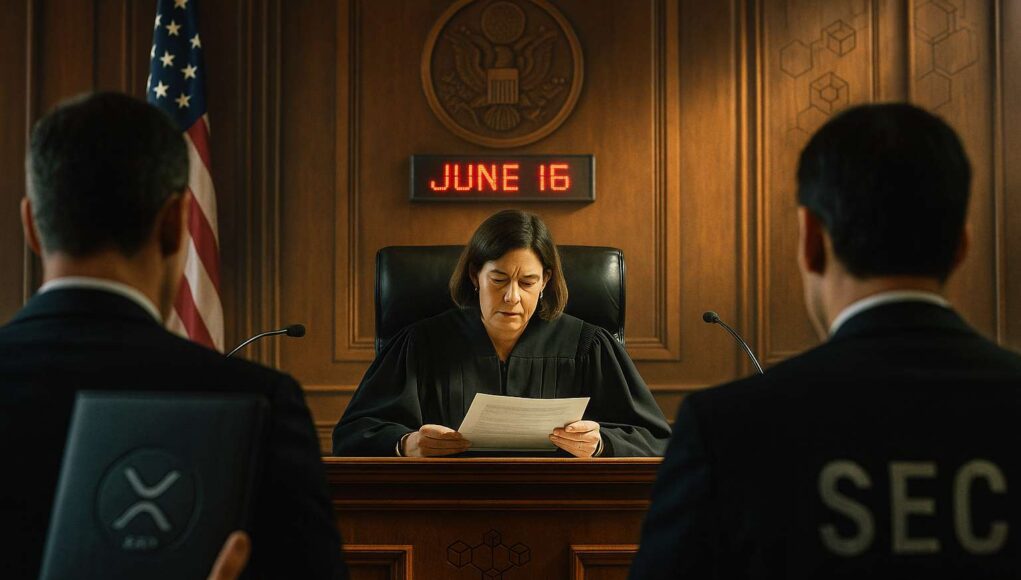Ripple and the U.S. Securities and Exchange Commission (SEC) are taking one last shot at ending their years-long legal dispute. On June 13, both parties filed a joint motion proposing a $102.6 million settlement to bring the Ripple SEC lawsuit to a close. With a final ruling expected by June 16, all eyes are now on Judge Analisa Torres. Her decision could mark the end of one of the crypto industry’s most significant legal battles.
What Sparked the Ripple vs. SEC Lawsuit?
The SEC first sued Ripple Labs in December 2020. The agency alleged the company had conducted an unregistered securities offering by selling XRP tokens. According to the SEC, XRP qualified as a security under U.S. law.
Ripple disagreed. It claimed XRP was a digital asset, similar to Bitcoin or Ethereum. The legal battle unfolded over nearly five years and involved multiple court phases. Both sides saw partial victories along the way. In a notable 2023 ruling, Judge Torres found that Ripple’s programmatic sales of XRP did not violate securities laws. However, questions around institutional sales remained unresolved.
The Proposed Settlement: What’s on the Table
Ripple and the SEC now want the court to approve a $102.6 million resolution. The proposed structure includes:
- $25 million as a civil fine to the U.S. Treasury,
- $75 million set aside for investor restitution,
- $2.6 million in interest.
The legal argument hinges on Rule 60(b) of the Federal Rules of Civil Procedure. This rule allows courts to modify a judgment when “extraordinary circumstances” apply. The parties argue that the drawn-out nature of the litigation and its evolving posture warrant reconsideration of the unresolved penalty.
>>> Read more: SEC Drops Ripple Lawsuit; XRP Futures Debut
The Strategic Timing
The June 16 deadline is more than symbolic. Both sides are aiming to avoid further delays, reputational damage, and costly appeals.
Ripple has long sought to remove the regulatory cloud hanging over its operations. The SEC, meanwhile, is under pressure to show progress in its enforcement actions. The proposed deal may serve both parties by preventing further market uncertainty. It also clears the path for Ripple to resume expansion and partnership efforts without legal overhang.
Judge Torres’ Role and the June 16 Decision
Judge Analisa Torres has presided over the case since it began. Her 2023 partial ruling provided clarity on certain XRP sales, but not all.
Now she must decide whether the joint motion qualifies under Rule 60(b). Some legal experts believe she may approve the deal, viewing it as a pragmatic resolution. Others caution that she could reject it if she believes it undermines standard appellate processes. A rejection would prolong the lawsuit and possibly reopen contentious issues.
Market Reaction and XRP Price Speculation
The crypto markets have reacted with measured caution. As of June 13, XRP is trading around $2.15, with intraday movement between $2.09 and $2.25. The filing of the joint motion has not triggered any sharp price movement, suggesting that traders may be waiting for Judge Torres’ final ruling before making directional bets.
Analysts note that previous legal milestones in the Ripple case have caused brief rallies, but these gains have often reversed quickly. Going forward, XRP’s price action will likely depend less on speculation and more on the clarity, tone, and timing of the court’s final decision.
Legal Experts Weigh In
The legal community remains divided. Some attorneys see Rule 60(b) as an acceptable path for complex cases like this. They argue the proposed settlement offers a balance between accountability and closure.
Others raise concerns about precedent. “If the court accepts this,” one securities lawyer told BraveNewCoin, “we’ll see every crypto defendant try the same strategy.” Critics fear it could open the door to negotiated penalties that bypass full judicial scrutiny.
>>> Read more: Ripple Hidden Road Acquisition: A Strategic Shift
The Ripple SEC lawsuit has become a defining test of how U.S. securities law applies to digital assets. This proposed settlement could finally close the chapter — but only if Judge Torres agrees.
With the June 16 decision fast approaching, the outcome could have wide-reaching effects. The ruling won’t just impact Ripple and XRP holders. It could shape how the SEC handles crypto enforcement for years to come.
Readers’ frequently asked questions
What happens if Judge Torres rejects the Ripple SEC settlement motion?
If Judge Torres rejects the joint motion filed under Rule 60(b), the unresolved parts of the Ripple SEC lawsuit may return to litigation. This would likely delay resolution for several more months and potentially lead to appeals.
What is the current XRP price trend as the Ripple SEC lawsuit nears resolution?
As of June 13, XRP is trading around $2.15, with intraday movement between $2.09 and $2.25. The joint motion filing has not resulted in significant price shifts, indicating that the market is holding steady while awaiting the court’s decision. Analysts suggest that future price movement will largely depend on the clarity and finality of Judge Torres’ ruling.
Why is Ripple using Rule 60(b) to settle the XRP lawsuit now?
Rule 60(b) allows courts to revise prior judgments under “extraordinary circumstances.” Ripple and the SEC argue that this prolonged legal battle and its evolving nature justify closing the case with a new motion and a $102.6M penalty structure.
What Is In It For You? Action items you might want to consider
Track the June 16 court ruling in the Ripple SEC lawsuit
If you hold XRP or follow regulatory precedent in crypto, the June 16 decision will likely set a tone for how similar lawsuits unfold. Monitor Judge Torres’ ruling for implications on crypto enforcement strategy.
Review your XRP exposure ahead of court resolution
Given recent XRP price volatility around lawsuit developments, traders may want to reassess their short-term risk tolerance before the ruling is announced.
Understand how Rule 60(b) might affect future crypto lawsuits
Legal analysts are watching this case closely because it could set a precedent. If the Ripple SEC joint motion is approved, other crypto firms may try to use the same legal pathway in settlement negotiations.










